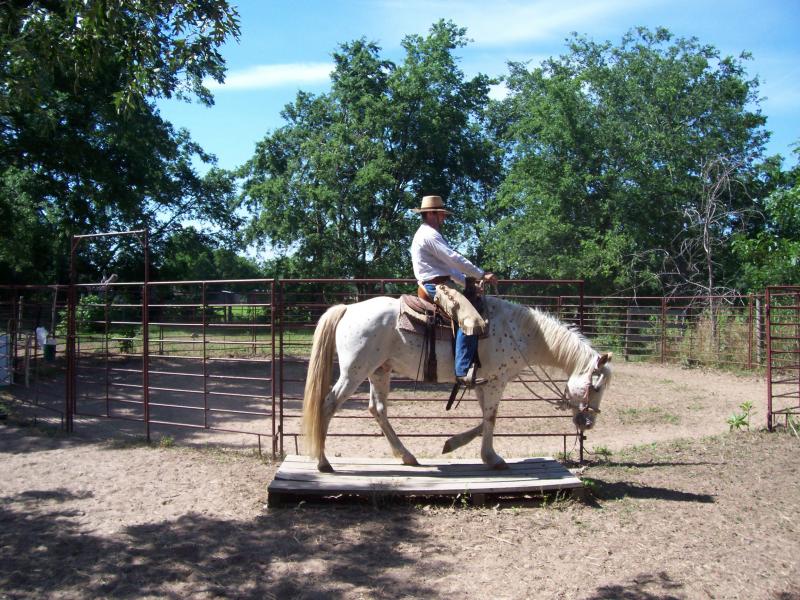Dennis Zeringue
Dennis Zeringue
11814 Farm Road 71 E
Sulphur Bluff, TX 75481
ph: 903-440-2829
dennis
Horse Training, Sulphur Bluff, TX
Providing training and lessons to clients in Hopkins Co. and all of northeast Texas.
Natural Horsemanship
Vaquero Style Horsemanship
Horsemanship for people of all ages, shapes, and sizes.
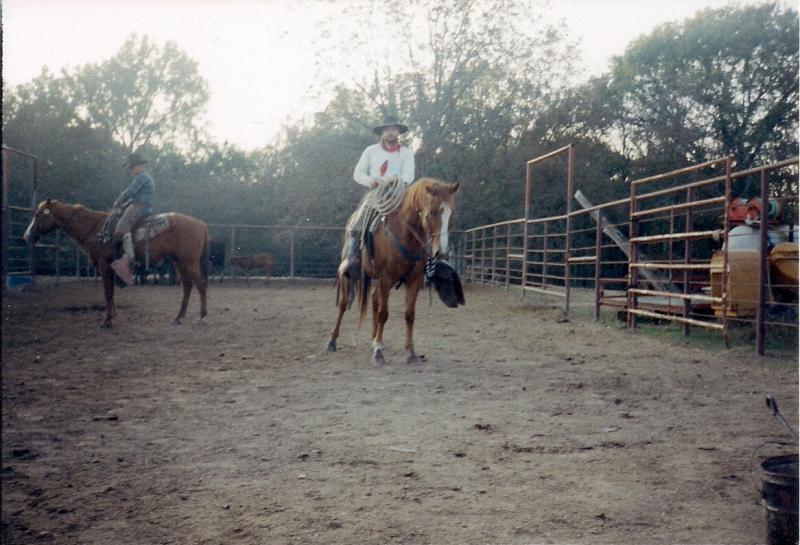
Preserving the Horsemanship of the California VaqueroHistory
I have been working in the livestock industry since 1982. I have earned my living working with horses and cattle by the use of my knowledge and skills. Now I'm willing to share my knowledge, my skills, and my experience with you. During my travels there where only a few men who were willing to share their knowledge and skills with me. Ridley Chauvin - calf roper/rancher, Bill Falgout - cutting horse trainer, and Norm Wright - cowboy/hackamore man, are some who gave me some basic skills, when I was just starting out. They gave me a foundation that I could get the job done with and then build on. Now only a small number of people know these men, but I list them here only to show my gratitude and so they may not be forgotten. After all these years I still use those basic skills every time I ride. I learned from every person I ever rode with, through observation. From some, I learned "what to do"; from others, I learned "what not to do". The horsemanship methods I use, I've learned the hard way, through trial and error. I use the methods that work and eliminate those that do not. I don't follow the crowd. Instead, I listen to my horse. Good methods give me good results. The methods I use are tried and true. Some have been made popular by the horsemanship clinicians. Others have been ignored or forgotten by the crowd because they require time, patience, and self-discipline. The methods I use are safe for the horse and the rider. They can be mastered by people of all ages, shapes, and sizes.
Training
When I train a horse I use a combination of natural horsemanship and vaquero style horsemanship. I use natural horsemanship techniques when I start horses or work with a problem horse. I use vaquero style horsemanship techniques as training advances. For those of you who are not familar with vaquero style horsemamship, it produces lightness in a horse and requires self-discipline of the horseman to maintain lightness. This doesn't mean that my horses are always on the bit with perfect vertical flexion. When we are traveling down the trail, my horses are ridden on a loose rein with their head in a relaxed position and reins swinging freely with the rhythm of their gait. When I am working cattle or doing dry work, I want my horses to perform with lightness, agility, and style.
I start horses in either a snaffle bit or a hackamore depending on the horse and the rider. Not all horses are hackamore horses. Some need to be started in a snaffle and then later on they can be ridden in the hackamore. As for the rider, most people do not have the skills to ride a horse in the hackamore. It takes certain skills and understanding, which must be practiced and mastered to a certain degree, before one will have success in the hackamore. When I speak of a hackamore, I am referring to a jaquima, made of braided rawhide, not a mechanical hackamore. Patience and understanding are the foundation of my training program. The horse sets the pace at which we progress. I have goals and expectations for the horse, but I do not set time limits. Every horse has different needs.
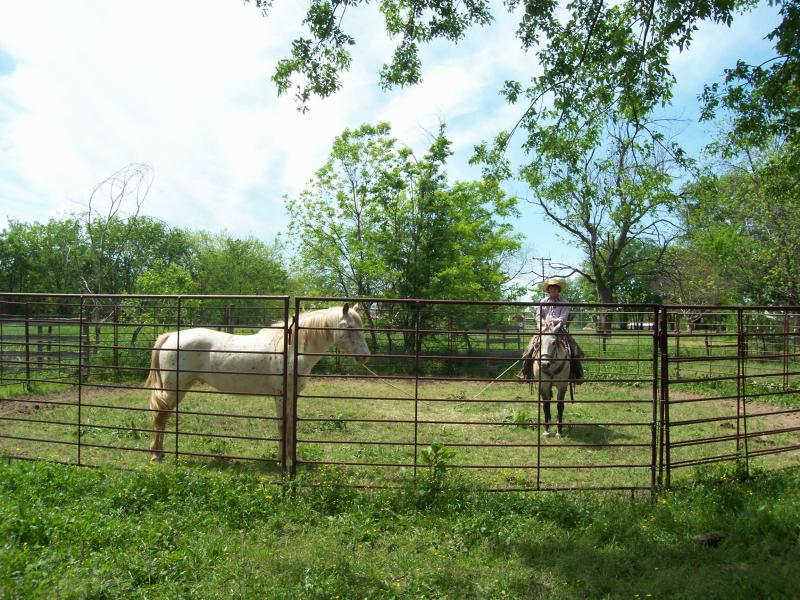 In this collection of photos you will see us working with Elliot, a five year old gelding who was not yet halter broke. Some people in his past had labeled him an idiot. His new owners wanted to give him a chance. This is photo number one. I roped him afoot. He handled ok, but he holds his head real high and away from you. This draws you right in front of him, while haltering. This is very dangerous, and the reason we haltered him from horseback. In this photo, I handed the lariat to my seventeen year old son Erin. He leads the horse around a little bit then stops to let him rest. I really like to stop and let a horse rest, calm down and soak in what we have been working on. I do this a lot. I work slow. It takes as long as it takes. I've never had a horse get upset because we were going too slow.
In this collection of photos you will see us working with Elliot, a five year old gelding who was not yet halter broke. Some people in his past had labeled him an idiot. His new owners wanted to give him a chance. This is photo number one. I roped him afoot. He handled ok, but he holds his head real high and away from you. This draws you right in front of him, while haltering. This is very dangerous, and the reason we haltered him from horseback. In this photo, I handed the lariat to my seventeen year old son Erin. He leads the horse around a little bit then stops to let him rest. I really like to stop and let a horse rest, calm down and soak in what we have been working on. I do this a lot. I work slow. It takes as long as it takes. I've never had a horse get upset because we were going too slow.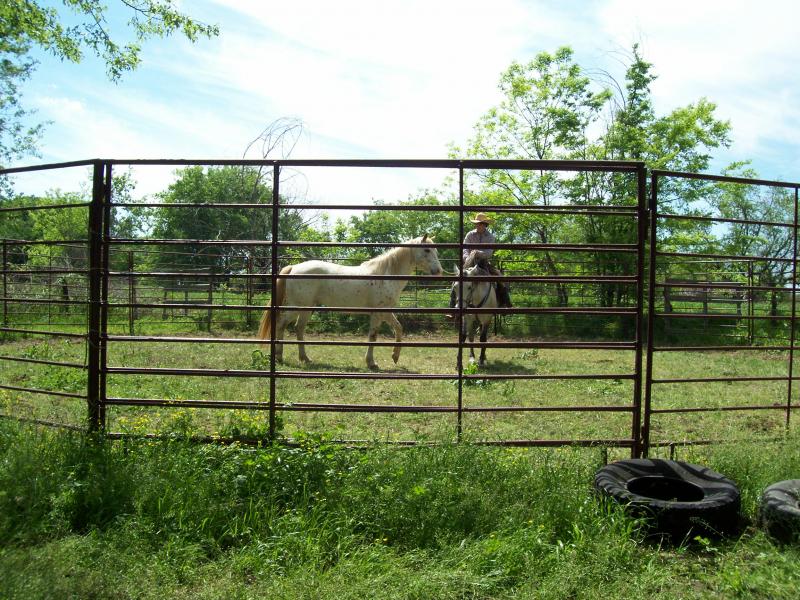 This is photo number two. In this photo, Erin is working his way up to Elliot. Erin first attempted to position his mare, Sandy, parallel to Elliot. Elliot did not accept this. After several attempts, without making any progress, it was time to try a different approach. In this photo, Erin is crossing the T. Elliot's body will make the vertical part of the T, and Sandy's body will make the horizontal part of the T. Erin is just riding toward Elliot's head. The goal is to have Elliot stop and allow Erin to rub his head. After this is acheived, Erin will again work on positioning Sandy parallel to Elliot, on Elliot's left side.
This is photo number two. In this photo, Erin is working his way up to Elliot. Erin first attempted to position his mare, Sandy, parallel to Elliot. Elliot did not accept this. After several attempts, without making any progress, it was time to try a different approach. In this photo, Erin is crossing the T. Elliot's body will make the vertical part of the T, and Sandy's body will make the horizontal part of the T. Erin is just riding toward Elliot's head. The goal is to have Elliot stop and allow Erin to rub his head. After this is acheived, Erin will again work on positioning Sandy parallel to Elliot, on Elliot's left side. 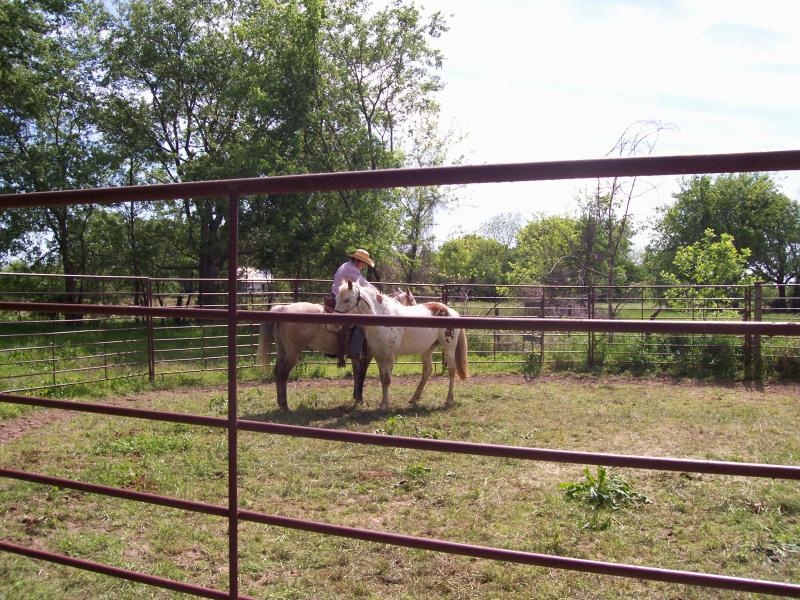
This is photo number three. As you see by this photo, Elliot did allow Erin to approach and rub his head. Erin then positioned Sandy parallel to Elliot. With a lot of rubbing and sweet talk from Erin, Elliot allowed Erin to halter him. In the above photo, Erin has worked his way around to Elliot's right side to do an equal amount of rubbing and sweet talk, while allowing Elliot to relax and enjoy. A rather uneventful process except for the three first that took place. One, Elliot allowed us to halter him, without us using any force, just finesse. Two, this is the first time Sandy has been used to work another horse. Three, this is the first time that Erin has worked a horse from horseback. By the end, all three were working in harmony. One of the skills that Erin had to master, was to ride one handed,holding the reins and coils of his lariat in his left hand, while his right hand was busy controlling Elliot, and doing this on Sandy who is not yet straight up in the hackamore. This is where having the ability to move your horse's hips and shoulders independently and simultaneously, with the use of your legs, comes into play.
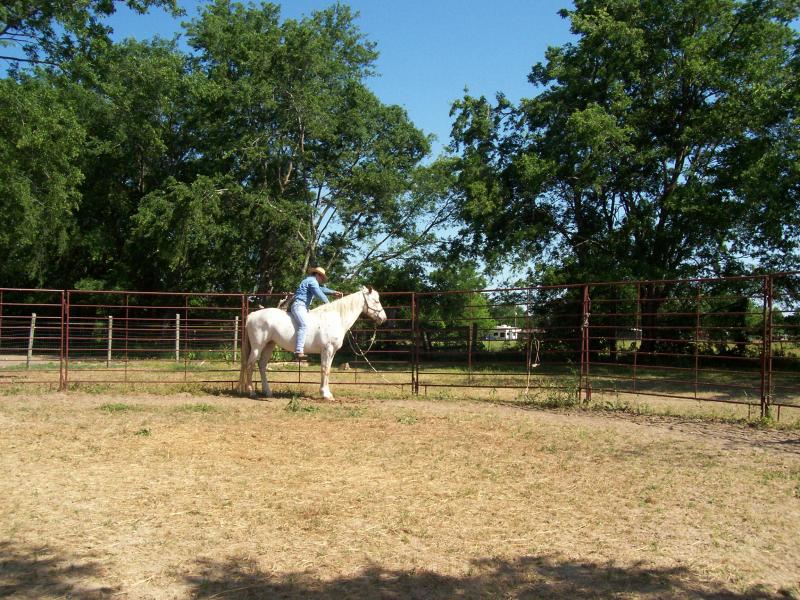
Ian mounting Elliot from the fence. I really like to do this before we saddle a horse for the first time. Mounting them bareback is the safest way to do this. It is also a great way to prepare them for the saddle.
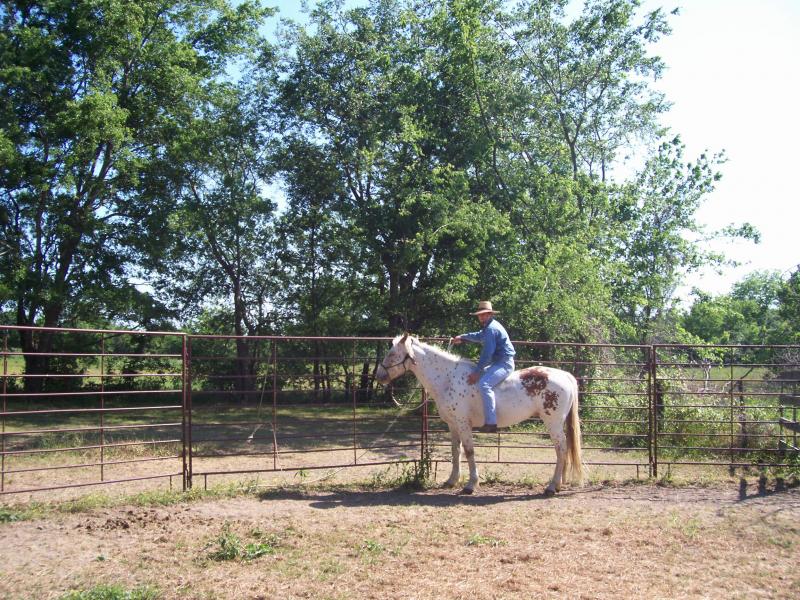
Ian mounting on Elliot's right side. It is important to always train both sides of the horse.
Elliot's second ride. Erin put the first ride on Elliot. It was a perfect first ride. Walk and trot inside the corral. Just relaxed and easy as can be. On Elliot's second ride, Ian started out in the corral. He rode Elliot at a walk, trot and lope. Everything went smooth so we opened up the gate and went for a ride in the horse trap.
Hobbles
An important aspect of vaquero style horsemanship is the use of hobbles. People who participate in horseshows and rodeos don't use hobbles. A lot of them don't know what hobbles are. These folks just tie their horses, to anything and everything. If the horse breaks the lead rope, they just get a bigger lead rope or buy the latest gadget sold by some clinician . People will use gimmicks and gadgets, but they won't use knowledge. A lot of cowboys use hobbles, but don't really understand the importance of hobble training to the entire training of the horse. Cowboys will hobble their horses, pull off the bridle and let them graze. Cowboys use hobbles as a practical tool. With hobbles, the horses can graze but won't wander too far and will be easy to catch. Proper hobble training teaches a horse to give to pressure, to be submissive, to be patient and to wait for the human to release them from their restraints. This has a psychological benefit which produces a horse, which everyone enjoys. Another benefit is the safety factor which can prevent a serious injury or even death. I recieved the following email from a client of mine.
I left this morning and thought Sebastian was just leaning across the fence. I didn't realize he was stuck. He must have reared up playing across the fence line and landed half on the other side. Dan came home and had to cut the fence to free him. Like always when he gets stuck or in trouble he just waits patiently for us to come take care of him. I am so thankful for the training you gave him (hobbling him) to prepare him for situations just like this. Thank you again for all you did for us with him. He is a wonderful baby. I hope all is well with you and your family. Take care and God Bless.
Lisa and Dan Colston
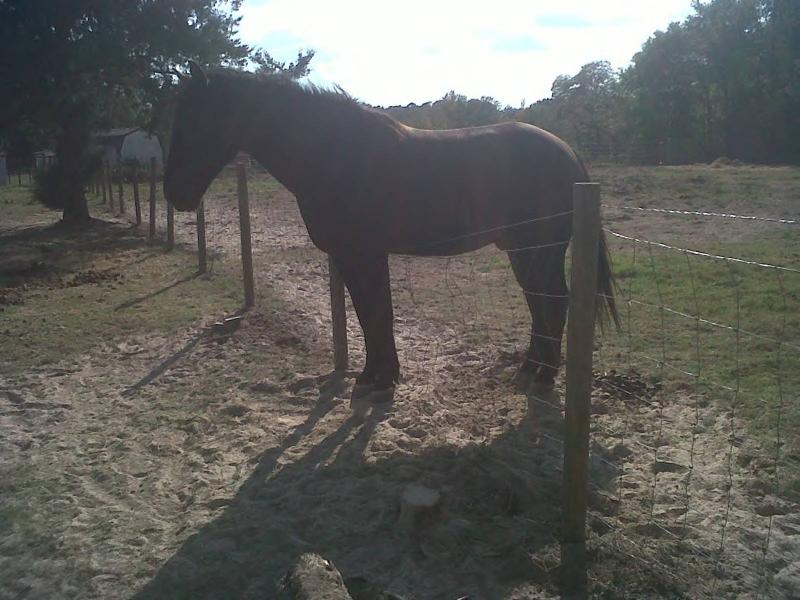
Sebastian is a Percheron. He came to me as a yearling for halter breaking and to be taught some manners. While he was with me he changed owners when Lisa Colston purchased him. He recieved a total of four weeks of ground schooling, which included hobble training. He came back to me at the age of three to be started under saddle. He spent six months with me then returned to Lisa. Sebastian is now receiving training in dressage.
For more information and prices you can contact me at: dennis@denniszeringue.com
Copyright 2010 Dennis Zeringue. All rights reserved.
Dennis Zeringue
11814 Farm Road 71 E
Sulphur Bluff, TX 75481
ph: 903-440-2829
dennis
